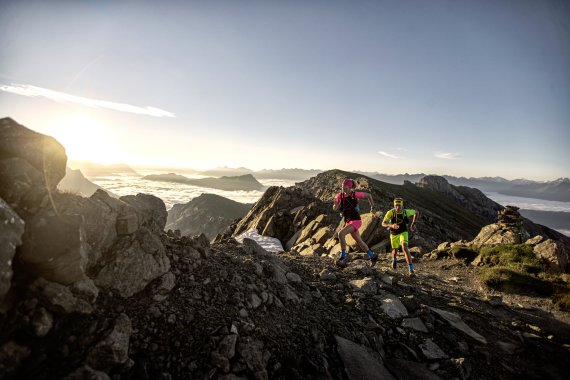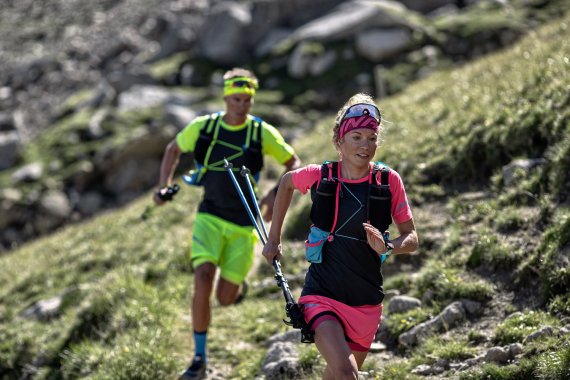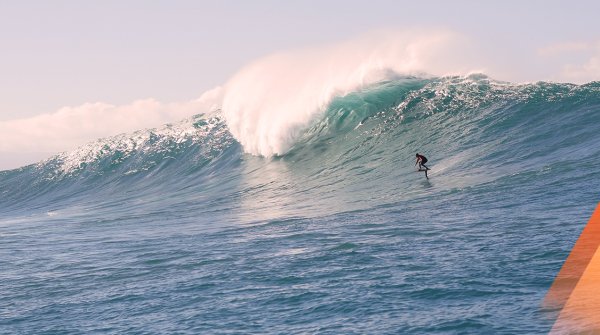
The dictionary reveals: The term trail running - also known as Traillauf - refers to all forms of running away from paved roads. This means: If you assume trail running in the broadest sense, it also includes the morning jog in the park. However, many die-hard trail runners also mean multi-day stages across the Alps and ultra-long distances far off the beaten track. But whether it's five or 50 kilometres, the main thing is to do sport in the great outdoors.
Typical running surfaces are forest and field paths, grass and meadows, single trails, paved paths, stone and scree paths, sometimes even sand.
The main goal and motivation of trail running is precisely this experience of nature. Unlike the marathon, trail running is not about best times. Due to the incline and decline, the run is always subject to fluctuations, and the pace is rarely the same during the entire run. Speed is therefore not a priority, especially when longer distances or even ultra runs are covered off-road. And so, for many runners, trail running is above all also one thing: self-awareness and overcoming. And often a completely new and different running experience in the midst of nature.

Trail running is different from running on the road or hard asphalt. At the same time, this trendy sport should by no means be equated with mountain running, where the focus is primarily on the steepest and fastest ascent possible. In addition, this is only practiced in the mountains. With trail running, however, hilly terrain is also part of it. A few meters of altitude are allowed. But: The route and the associated terrain as well as the conditions are much more varied than with mountain running.
Depending on the route and the weather conditions, the runner will have to cope with a lot. As a runner, you will encounter fine pebbles, scree, rock, grass, mud or sometimes snow during trail running. Besides endurance and technique, balance and concentration play an important role. And last but not least, you need the right equipment.

The good news for all trail running beginners: It's a myth that trail running requires you to complete all parts of the course at running pace. Depending on the gradient, this is often not possible. On a trail run, you tend to alternate between walking and running in the uphill sections. Sometimes fast walking is even more economical. The ascent in steep passages can be made easier by supporting yourself on your thighs. Or you can use special running poles to save energy during the ascent.
Downhill, the poles are usually gripped in the middle for balancing and carried on the side of the body. In this way the balance can be kept well and the runner does not fall over the poles. Downhill is as much about good technique as concentration. On the downhill slope, it is important to cushion the impact and land safely on the forefoot. In contrast to running on asphalt, the arms are spread out away from the body - like wings - to keep your balance better and to compensate for unevenness.
The important thing, both uphill and downhill, is to stay relaxed, have fun while running, and engage with the terrain. As a trail beginner, you'll quickly realize that trail running is a full-body sport that works your muscles and coordination intensively.

The most important thing when trail running is choosing the right shoes. While you can also run a trail lap in ordinary running shirts and shorts, the profile and stability of the footwear are crucial. Trail running shoesare now available in a wide variety of designs, from entry-level shoesFrom the beginner shoe, to the ultra shoe with more cushioning, to the more direct competition shoe.
As a rule, trail running shoes have a different sole profile than shoes for road running. The outsole is constructed differently, the rubber coating provides better grip on uneven surfaces, studs and a deeper relief provide additional safety on muddy paths and muddy trails.

- Running clothes
- Alternating shirt
- Running jacket
- Running backpack or if necessary running belt
- Running watch with GPS function
- Headband
- Sunglasses
- Sticks
- Snack(s), e.g. nuts, bars or gels
- Hydration bladder or soft flasks
- Water for on the way

Of course, the equipment also depends on the altitude, temperature and length of the lap. For a short 5-kilometer loop from home, you don't necessarily need a change of clothes or a running backpack. And even poles are not worn by all trail runners. In the end, everyone runs for themselves and must try out what suits their own needs best.
Besides the shoes with tread, the running backpack is also a special piece of equipment when it comes to running in the mountains or on longer trails. Since you usually have to take care of yourself on the trail, you should pack enough water and also some provisions. At the same time - and this is the big challenge - it is important to pack as minimalistically as possible. A running backpack that hugs the body is ideal here. Smaller than a hiking pack, it still has room for essentials like bars, hydration bladder, or softflasks, soft containers that can be stowed smaller when empty. Most running backpacks or vests have room for a change of shirt, headband, or thin running jacket in addition to space for your water supply. Likewise, most backpacks have a zippered compartment to safely store your keys or some money.

Basic endurance is not wrong when it comes to the first trail run in the mountains. Just as a reasonable self-assessment and a little running experience, so that you can put away five to ten kilometers in one piece. Generally speaking, depending on your ability and athletic fitness, it's not a bad idea to get to grips with the mountains, both in terms of altitude and distance. Many sports shops, running equipment manufacturers, travel agencies with a focus on sports or mountain schools and trail coaches offer taster courses, guided tours or running camps where you can get to grips with trail running under supervision.
Once you have taken a liking to the sport, there is often no stopping you, the distances become longer and the first competitions more attractive. When it comes to measuring the skills of more ambitious runners in competitions, specific training plans and often also a change in diet can help to optimise physical conditions and to remain successful and injury-free.
There are now different formats of races and competitions for trail enthusiasts. Differences in distance and routing ensure that there is something for everyone, whether hobby runner or trail pro. Many events offer staggered distances, allowing both amateur and professional runners to participate.
One of the most famous, but also toughest races, where the best athletes in the world compete in trail running is the Ultra-Trail de Mont BlancUTMB for short, with start and finish in Chamonix in the French Alps. The UTMB circles the Mont Blanc massif, and there is a distance of about 168 kilometers and more than 9000 meters of altitude to overcome.
Events have also existed in trail running for a long time: The oldest race in the USA is the Dipsea Race and has been taking place with interruptions since 1905.
A number of trail running competitions also take place in Germany. The biggest are the Rennsteiglauf in the Thuringian Forest and the Zugspitz Ultra Trail in the Alps with a start in Garmisch.
- ISPO awards
- Mountain sports
- Bike
- Design
- Retail
- Fitness
- Health
- ISPO Job Market
- ISPO Munich
- ISPO Shanghai
- Running
- Brands
- Sustainability
- Olympia
- OutDoor
- Promotion
- Sports Business
- ISPO Textrends
- Triathlon
- Water sports
- Winter sports
- eSports
- SportsTech
- OutDoor by ISPO
- Heroes
- Transformation
- Sport Fashion
- Urban Culture
- Challenges of a CEO
- Trade fairs
- Sports
- Find the Balance
- Product reviews
- Newsletter Exclusive Area
- Magazine








